- Home
- How to
- How to
- Services
- Services
- Maintenance Plan
- Location
- Guides
- Guides
- No Hot Water – Self help
- Unvented Water Heater
- Unvented Water Heater Faults
- G3 Building Regulations
- Thermal Store Water Heaters
- Thermal Store Faults
- Gledhill ElectraMate
- Gledhill PulsaCoil
- Gledhill Torrent
- Gledhill Stainless Lite
- OSO Unvented Heater
- MegaFlo – Heatrae Sadia
- Santon Premier Plus
- Albion
- Manco Riverstream and Powerstream
- Manco Gladiator & Stirling
- Telford Tempest
- Safety Considerations Unvented Cylinders
- Reduce Your Water Heating Bill
- Range Tribune
- About Us
- About us
- Forums
- Contact

Unvented Water Cylinder Engineers
G3 Qualified
-
Call Now
0161 941 5571
Unvented Water Heaters
Unvented Water Heaters
There are two common types of water heaters used in residential applications today – vented and unvented. While vented hot water heaters are perhaps the more common of the two, unvented water heaters are quite popular. They provide good flow rates at taps and appliances, and require less installation space than conventional gravity systems (vented hot water heaters).
Also unlike conventional gravity hot water systems, unvented water heaters do not have a feed and expansion tank located above them, and there is no need for a vent pipe. In a gravity system, the vent pipe is open to the atmosphere and prevents unwanted pressure build-up within the system. The key difference between the two types of systems is the fact that unvented boilers are sealed. This is also why installation of these systems is strictly controlled by part G3 of the building regulations.
It should also be noted that direct unvented water cylinders require the skills of a plumber qualified to work on unvented heaters and a part “P“ registered electrician, as their function requires both skill sets. At EasyFlow, we have both qualified plumbers and electricians to handle these situations.

Albion Stainless HE
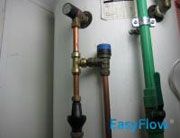
Albion TPE and Expansion Valves

Draining down the cylinder
How Do Unvented Water Heaters Work?
Unlike gravity systems, unvented water heaters rely on the pressure and flow of water from the mains for their own water pressure and flow. If the incoming water pressure and flow is insubstantial, installing an unvented water heater will not alleviate the problem.
In an unvented system, the incoming mains water first passes through a stop cock, line strainer, a pressure reduction valve and a check valve before it enters the water cylinder. The pressure reduction valve would typically reduce incoming water pressure to three bars. Water can be heated directly by immersion heaters in the case of direct electric systems, or indirectly by a boiler, a primary circuit and a heating coil.
As the water temperature rises, so does the volume of water in the cylinder. Heated water is now trapped between the closed hot water taps at the point of exit and the single check valve at the point of entry. As the water expands, the pressure within the cylinder increases beyond the initial three bars of pressure. The expansion is taken up by an expansion vessel, or in the case of a MegaFlo, an expansion bubble within the water cylinder itself. The expansion vessel contains a flexible membrane and is charged to a similar pressure as the static pressure of the tank.
Water stops expanding when the heat source is removed. In a direct system, the immersion heater-mounted thermostats would keep the water temperature below 65 degrees centigrade. Unvented water cylinders are highly insulated, so they require heating only once per day to provide enough heated water to supply household needs for a full 24-hour period.
Obviously, if the thermostat mounted to the immersion heater failed, the water would continue to be heated beyond the 65-degree point. As a result, expansion would continue increasing, and pressure would build within the cylinder. Apart from the risk of scalding, the real danger occurs when the temperature passes 100 degrees centigrade. At this point, there is a significant risk that water would transform to steam, which could then expand 1600 times the volume of water and cause an explosion. This is where the safety devices built into unvented water heaters come into play and prevent the risk of dangerous situations.
The first level of defence is an overheat cut-out. If the temperature passes 85 degrees, the overheat thermostat would activate and eliminate the danger. The overheat thermostat must be manually reset, though, and this should be done in conjunction with a safety inspection.
If the overheat thermostat were to fail, a temperature and pressure relief valve would activate at 95 degrees. The valve opens, allowing hot water to exit the tank safely via a discharge pipe and tundish, connected to the drain. In turn, this allows cold water to flow into the tank and further reduce the temperature.
Additionally, there is another expansion valve set to six bars, which opens if the pressure within the cylinder rises above the safety threshold.

Showing no Pressure in Cylinder
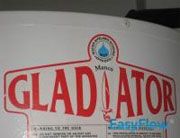
Manco Gladiator
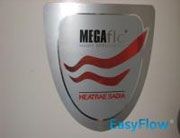
Mega Flow
How to Operate an Unvented Water Heater
While very different from gravity systems, unvented water heaters are efficient and easy to use provided you understand how they operate and how to set the controls. The section above outlined how unvented water heaters function, and now it’s time to discuss how to get the best operation out of your water heater.
Most direct unvented water heaters have two immersion heaters. One is located at the bottom of the water cylinder itself. The second is located about halfway up the cylinder. If your unit only has a single immersion heater, it will be located at the bottom of the cylinder. The lower unit is always the primary heating element. If you own an Economy 7 or similar supply, the main immersion heater will operate during “economy supply hours“, which are typically after midnight, and will heat water for up to seven hours (or the number of hours specified in the model designation). If you do not own an economy electrical supply, you can operate the main immersion heater at any time of day or night. The main heating element should always be fitted with a time control to avoid costly electricity bills. Use this to your advantage, while tailoring the heating schedule to your specific usage needs.
While the lower heating element is called the “main“, the second heating element (if so equipped) is called the boost. This heating element can be operated at all times, day or night, even with economy supplies. Again, this element can be controlled with a timer to ensure maximum hot water availability on your schedule.
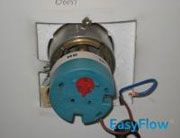
Replacementr Immersion Heater Thermostat
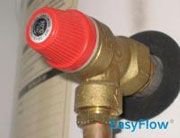
Temperature and Pressure Relief Valve
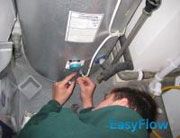
Removing Heater the Electrical Connections
Using the Boost Function on an Unvented Water Heater
As mentioned, the second heating element located midway up the cylinder is called a “boost“. Generally speaking, you should turn it off and leave it off until it is needed. The lower heating element should provide more than an adequate supply for your hot water needs. Economy 7 users will have a timed function on the supply. Other users will have to set the amount of time they wish to heat the water on the time clock. Six hours of heating should be sufficient in most instances, and it is best to heat the water from midnight until 6:00 AM.
The boost heating element is used to “top up“ the water temperature within the cylinder outside of the times mentioned above. It’s an important feature for temporary higher usage needs. For instance, a number of people may have just showered and another would like to shower, but the water is not hot enough. Using the upper boost immersion heater for an hour would ensure enough hot water for this.
It is important to note that the interior of your water cylinder is not segmented – it is a single open cylinder. However, because of the shape, heated water is stratified into layers with colder water at the bottom and hot water at the top. As hot water is drawn from the top of the cylinder, it is replaced by colder water from the bottom. The more hot water being used, the more cold water will fill the cylinder. Using the boost immersion heater applies heat to the already warm (but not completely hot) section of the cylinder.
In most unvented water heaters, both the main heater and the boost heater are rated at 3 kW. In some water heaters, they are identical, such as the Santon Premier Plus. However, in some systems, they differ, with the lower heating element being curved and elongated.
At EasyFlow, we guarantee the work we undertake for you, but we will not guarantee manufacturers’ parts. Manufacturers generally offer a 12-month warranty on parts, which we pass on to our customers. Note that some manufacturers do not offer a warranty on a new part that has been installed on an old water heater.

Replacement Control Unit Place

Temperature and Pressure Relief Valve
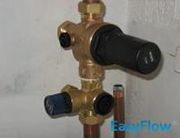
Installing the Replacement PRV
Unvented Water Heater Makes and Models
A number of manufacturers produce unvented boilers. These include:
- Telford Tempest stainless steel cylinders
- Santon Premier Plus
- Gledhill ElectraMate
- Heatrae Sadia MegaFlo
- Valliant Vantage
- Albion
- Manco
- Kingfisher
- And many others
Each manufacturer produces cylinders designed to operate reliably under the increased stresses produced by high temperatures and pressures. Call EasyFlow today for more information on repairs or annual maintenance on your existing unvented water heater, or to discuss the installation of a new unvented water heater.
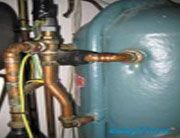
Expansion Valve on Manco Gladiator

Mega Flow Raining Down the Tank
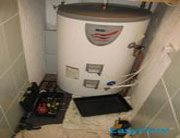
Mega Flow Unvented Water Heater
Annual Service for Unvented Water Heaters
Most unvented water cylinders require annual maintenance, as specified by the manufacturer. In addition, the service record should be signed and dated by the professional servicing the unit. At EasyFlow, we operate an annual service register to make this simple to remember. We send reminder cards close to the annual service due date, and then follow up with a reminder phone call to book the service appointment with a plumber. We also provide you with a service logbook if your installation/service logbook provided by the original installer has been misplaced. Your service history is also kept on file at our office should that information be required. Call EasyFlow today at 0800 433 4043 and sign up for annual unvented water heater service – we’re proud to serve all of Manchester, Liverpool, Chester and Leeds areas.
If you need assistance with any hot water heater repairs, to schedule hot water heater maintenance, or to install a new hot water heater, call EasyFlow at 0800 433 4043
Call an EasyFlow Engineer Today
Find out more about EasyFlow Maintenance Plan.
Our maintenance plans are designed to ensure our customers enjoy peace of mind, and constant hot water. We keep your hot water flowing while minimising your costs and eliminating stress. Let our experts identify and correct water heater faults, while you enjoy low monthly payments
Joanne, Warrington
8 January 2024
Annual Service
Richard, Bolton
14 December 2023
Annual Service
Brian, Wilmslow
15 December 2023
Annual Service
Waheed, Hertfordshire
1 January 1970
No Hot Water
Excellent service as usual.Despite the terrible weather and the lift being out of order
JUDITH, Glossop
28 December 2023
Annual Service
Peter, Liverpool
30 November 2023
Annual Service
Jonathan, Liverpool
22 November 2023
Replacement Valves
Dominic, Chorlton
6 November 2023
Heating Control Replacement
An excellent service as usual and Chris was very helpful and informative.
Derek, Chester
2 October 2023
Annual Service

© 2025 Country & Town Limited. All rights reserved EasyFlow is a Country & Town Limited service







Find out what our clients are saying about the services we provide
Click to view